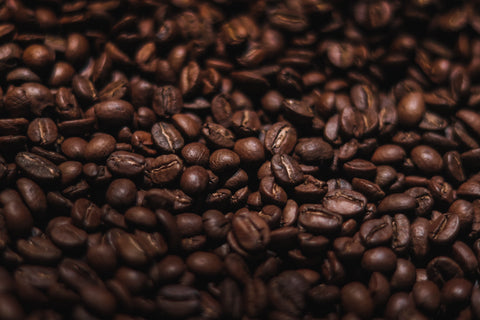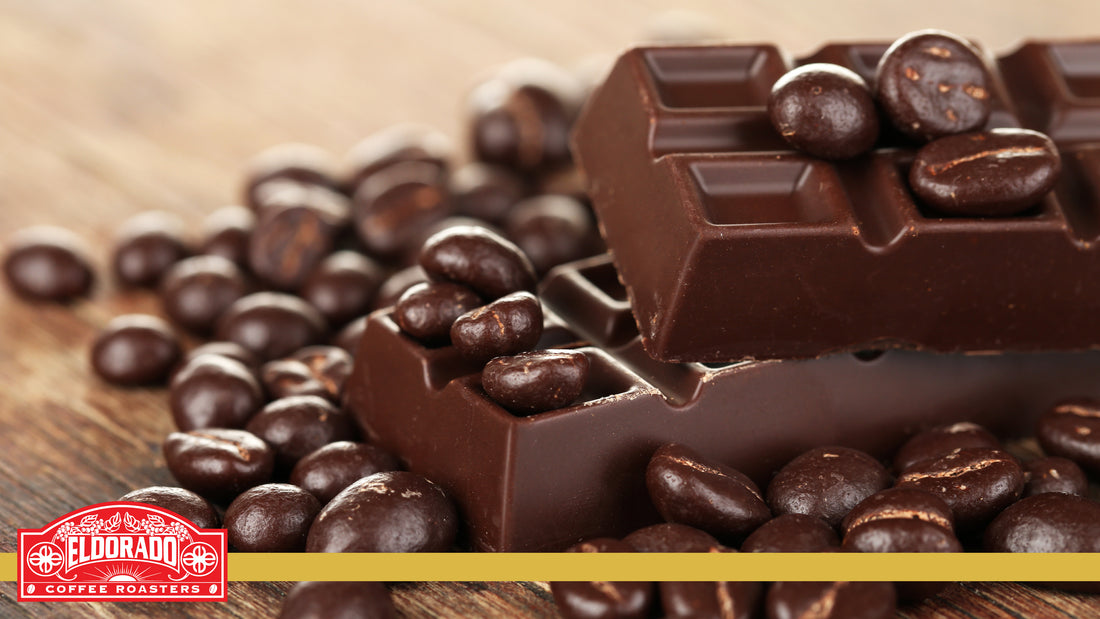Chocolate covered coffee beans are our “guilty” pleasure… But there’s actually nothing to be guilty about when you have them. The health benefits of coffee beans paired with the antioxidants of dark chocolate makes this a sweet treat worth celebrating.
We’re giving you all things chocolate-covered espresso beans in this guide. We’ll answer the question, “are chocolate-covered espresso beans caffeinated?” You’ll get the rundown on how to eat them safely, and how to make the best homemade coffee beans in your own kitchen. So let’s get snacking.
Are Espresso Beans Safe to Eat?
Despite circulating misinformation, it is safe for most people to consume coffee and espresso beans. You don’t have to skimp on this treat, as long as you know how to eat chocolate-covered coffee beans safely.
Eating Roasted Coffee Beans
The coffee bean is actually the fruit of the coffee plant. The coffee fruit is similar to any other seed or fruit that has an outer casing, like a banana or lemon.
You don’t usually want to eat this green coffee bean, because it’s bitter and hard to chew. But once you roast the beans, they soften and taste tangy and delicious.
In order to consume coffee beans, producers remove the coffee fruit’s external casing. Then they dry and roast the beans inside. Those green beans turn brown during roasting, which gives that brown coffee bean we know and love. At that point, you then typically grind and brew those beans to make coffee.
Rather than grinding, though, you can munch on those roasted coffee beans themselves. In fact, roasted coffee beans have the same nutrients and health benefits as drinking a cup of coffee, but in a more concentrated form.
Not everyone loves the flavor of whole coffee beans on their own. That’s why chocolate-covered coffee beans are so popular. The dark chocolate helps moderate the taste, add a bit of sweetness, and soften the crunch to create the best bite of sweet and tangy!

Are Chocolate-Covered Espresso Beans Caffeinated?
Coffee beans are caffeinated. They’ll give you a boost of energy and alertness, just like a strong cup of java would.
In fact, whole coffee beans have a higher concentration of caffeine than a brew. Coffee (the drink) is diluted with water (and sometimes sugar and cream), so the beans are actually a more concentrated form of that caffeine.
Also, studies show that eating coffee beans may have a faster rate of absorption into the bloodstream through the lining of your mouth. This means you may feel the effects of the caffeine faster and stronger.
Because chocolate-covered coffee beans have a high concentration of caffeine, it’s important to eat them in moderation. Just like you don’t want to chug 20oz of coffee in one sitting, you don’t want your heart and hormones to go crazy after an entire bag of dark chocolate-covered espresso beans.
How to Eat Chocolate-Covered Coffee Beans
The biggest question we often hear is, “how many chocolate covered coffee beans can I eat in one sitting?” This ultimately boils down to the question of sugar and caffeine intake.
On average, the FDA recommends no more than 400mg of caffeine per day. This can vary based on weight, age, medications, and other factors, like how fast your body metabolizes caffeine.
Typically, one chocolate covered coffee bean has about 12mg of caffeine. This includes the caffeine from both the coffee bean and the dark chocolate (dark chocolate also contains small amounts of caffeine).
If we’re going on the 400mg limit, that means you can have around 30 beans without exceeding your caffeine limit, if you drank no other caffeinated beverages during the day.
It’s important to note, though, that caffeine content can vary drastically based on size, bean type, roast, and more. For example, Robusta coffee beans can contain nearly 2x as much caffeine as Arabica coffee beans. Make sure you check the label before eating handfuls of chocolate-covered coffee beans.
What Happens if You Eat Too Many Chocolate-Covered Espresso Beans?
Eating coffee beans in moderation is okay. Since they’re full of caffeine, though, you want to be careful about how much you’re consuming. Too much caffeine can lead to sleep disturbances, dehydration, diarrhea, increased anxiety symptoms, headaches and more.
Coffee beans contain catechols, which have been shown to increase stomach acid. This can lead to heartburn, upset stomach, bloating, and nausea.
Again, moderation is key. Even the best chocolate-covered espresso beans require some level of self-control. You’ll likely see fewer side effects if you consume small amounts of dark chocolate covered espresso beans throughout the day, as opposed to all in one sitting.
If you’re pregnant, you also should be watching your consumption of caffeine — which includes the caffeine in chocolate-covered coffee beans.

Homemade Chocolate-Covered Espresso Beans
Want to make your own dark chocolate-covered espresso beans right in your own home? It’s an easy snack to make yourself, and an even easier snack to enjoy throughout the day. They also make the best homemade gift for the foodies in your life.
This recipe is so simple that you’ll love making these snacks! Here’s how you do it.
Choose your Chocolate
First, you’ll need to select your chocolate. Dark chocolate is healthier, with a higher antioxidant count. The greater the percentage of cocoa in the chocolate, the healthier it is—but also the more bitter it is. We typically opt for dark chocolate with 70% cocoa because it’s full of antioxidants and nutrients but it’s still sweet and delicious.
If you want to get a little fancy with your chocolate covered coffee beans, try out different flavored chocolates, like hazelnut chocolate or sea salt dark chocolate.
Hu chocolate is vegan, dairy-free, organic, and low in sugars (without refined sugar or sugar alcohols). It’s one of the best chocolate bars to munch on or melt down for your homemade coffee bean treat.
Get Your Coffee Beans
Next, you’ll select the type of coffee beans you’re going to use. There are two distinctions when choosing your beans: coffee type and roast.
Coffee Bean Types
There are four main types of coffee beans grown around the world: Arabica, Robusta, Liberia, and Excelsa.
Arabica beans make up about 60% of the world’s coffee consumption. They’re high quality and tasty bean with moderate caffeine levels, which makes them perfect for chocolate-covered coffee beans.
Robusta beans account for nearly the remaining 40% of coffee consumption. It has nearly 2x the caffeine as Arabica, and the flavor profile is slightly earthy and bitter. It’s not as common for munching on as a bean, but some people prefer this tangier taste.
Liberica beans and Excelsa beans are also options, but they’re a lot less common. You’re not likely to run into these often.
Roast
Next, you’ll want to consider the roast of the bean.
- A light roast is roasted for a shorter period of time, will retain more of its caffeine and acidity. This can work well with milk chocolate to balance the flavors, but it might taste too tangy with dark chocolate.
- A medium roast is the most popular in roast America. It has a balanced flavor and aroma, and it’s moderate on the palate. This roast tastes mild when covered in chocolate.
- A dark or espresso roast has a heavier and spicier taste, and it feels fuller in the mouth. It’s been roasted for longer, so it has slightly less caffeine than a lighter roast.
Find your perfect roast here.
Espresso beans (a dark roast) are most commonly used for coffee bean snacks. That’s because espresso beans tend to have a smoother, fuller flavor with less acidity, so they’re more palpable for eating. Check out our espresso bean offerings here.
Plus, pairing dark chocolate and espresso together is a match made in heaven. They have complementary flavor notes that create a symphony on the palate.
Dark chocolate-covered espresso beans are our snack of choice for the break room at Eldorado!
You can learn more about the difference between coffee beans and espresso beans in this article.
Process for Making the Best Homemade Chocolate-Covered Espresso Beans
For the best chocolate-covered espresso beans, you’ll need about 1 cup of espresso beans and 1 high-quality dark chocolate bar.
- Line a baking sheet or plate with parchment paper. Set aside.
- Create a double boiler on the stove. You can do this by heating a pot filled with water and putting a heat-safe glass bowl on top of it (don’t let it touch the water). Learn how to make your own double boiler here.
- Heat the chocolate in the glass bowl, stirring until melted. Stir continuously to avoid burning.
- Once the chocolate has melted, remove from heat.
- Put the coffee beans inside the melted chocolate bowl. Using a spoon, mix the coffee beans so they’re covered in chocolate.
- Using a fork, remove the beans one at a time and let the excess chocolate drip off.
- Place the beans in a line on the parchment paper.
- Let the beans sit at room temp for a few hours to cool and dry.
- Remove beans from the baking sheet carefully. You can use your fingers or a fork.
- Store in an airtight container in the fridge.
- Pop them in your mouth cold whenever you’re looking for a delicious snack!
These homemade chocolate covered coffee beans should last about 2-4 weeks if kept in the fridge.
Enjoy Your Homemade Chocolate-Covered Espresso Beans!
In moderation, homemade chocolate-covered espresso beans can be the best delicious and nutritious treat. They’re easy to make at home and even easier to enjoy and love!
We recommend our Havanero Espresso whole beans as your snacking bean! Covered in rich dark chocolate, these espresso-roasted beans are absolutely irresistible. They’re gone within an hour when someone makes them for our office or roaster!
Try our quality espresso beans for yourself to taste the difference.

